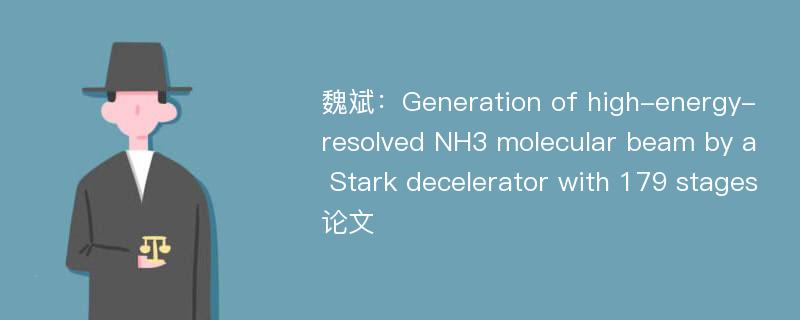
本文主要研究内容
作者魏斌,侯顺永,郭恒娇,纪亚兵,李胜强,印建平(2019)在《Generation of high-energy-resolved NH3 molecular beam by a Stark decelerator with 179 stages》一文中研究指出:We demonstrate the production of cold, slow NH3 molecules from a supersonic NH3 molecular beam using our electrostatic Stark decelerator consisting of 179 slowing stages. By using this long Stark decelerator, a supersonic NH3 molecular beam can be easily decelerated to trappable velocities. Here we present two modes for operating the Stark decelerator to slow the supersonic NH3 molecules. The first is the normal mode, where all 179 stages are used to decelerate molecules, and it allows decelerating the NH3 molecular beam from 333 m/s to 18 m/s, with a final temperature of 29.2 mK.The second is the deceleration-bunch mode, which allows us to decelerate the supersonic NH3 beam from 333 m/s to 24 m/s,with a final temperature of 2.9 m K. It is clear that the second mode promises to produce colder(high-energy-resolution)molecular samples than the normal mode. Three-dimensional Monte Carlo simulations are also performed for the experiments and they show a good agreement with the observed results. The deceleration-bunch operation mode presented here can find applications in the fields of cold collisions, high-resolution spectroscopy, and precision measurements.
Abstract
We demonstrate the production of cold, slow NH3 molecules from a supersonic NH3 molecular beam using our electrostatic Stark decelerator consisting of 179 slowing stages. By using this long Stark decelerator, a supersonic NH3 molecular beam can be easily decelerated to trappable velocities. Here we present two modes for operating the Stark decelerator to slow the supersonic NH3 molecules. The first is the normal mode, where all 179 stages are used to decelerate molecules, and it allows decelerating the NH3 molecular beam from 333 m/s to 18 m/s, with a final temperature of 29.2 mK.The second is the deceleration-bunch mode, which allows us to decelerate the supersonic NH3 beam from 333 m/s to 24 m/s,with a final temperature of 2.9 m K. It is clear that the second mode promises to produce colder(high-energy-resolution)molecular samples than the normal mode. Three-dimensional Monte Carlo simulations are also performed for the experiments and they show a good agreement with the observed results. The deceleration-bunch operation mode presented here can find applications in the fields of cold collisions, high-resolution spectroscopy, and precision measurements.
论文参考文献
论文详细介绍
论文作者分别是来自Chinese Physics B的魏斌,侯顺永,郭恒娇,纪亚兵,李胜强,印建平,发表于刊物Chinese Physics B2019年05期论文,是一篇关于,Chinese Physics B2019年05期论文的文章。本文可供学术参考使用,各位学者可以免费参考阅读下载,文章观点不代表本站观点,资料来自Chinese Physics B2019年05期论文网站,若本站收录的文献无意侵犯了您的著作版权,请联系我们删除。
